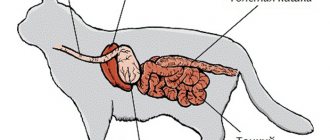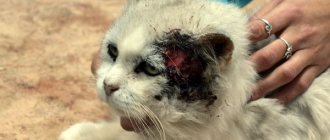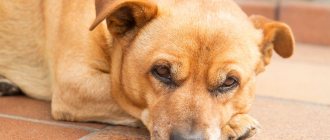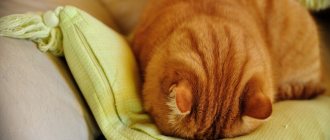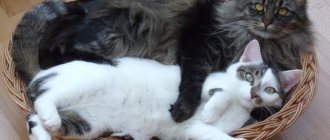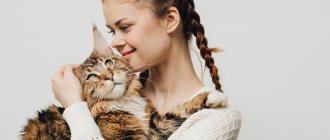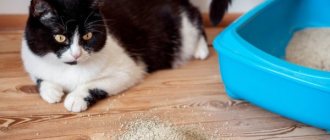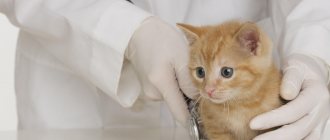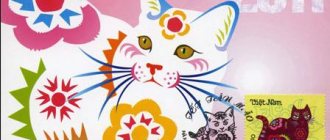Not only people, but also pets face the problem of excess weight. Obesity is the accumulation of fat in the body, which causes weight gain. At the same time, fatty layers form under the skin and around the internal organs. Does obesity in cats affect their health?
Obesity in cats - a problem or not?
What is obesity?
Obesity in cats is a process of deposition of fat in organs and subcutaneous tissue. This problem affects not only people, but also many animals. According to statistics, 25 - 40% of our four-legged friends suffer from a similar problem. Very often, obesity is associated with poor diet, lifestyle of the animal and related ailments.
It's a shame, but very often the owners themselves become the culprits when an animal becomes fat. Excessive care for your pet and the desire to feed it something tasty lead to negative consequences.
How does obesity occur?
Veterinarians like to say that “weight doesn’t come out of thin air.” Most often, excess fat occurs due to unspent calories or due to their excess intake from the outside. There may be several reasons for this pathological condition:
- overeating due to abundant feeding of the animal;
- use of unbalanced feed;
- sedentary lifestyle;
- cat's hereditary tendency to be overweight;
- metabolic disorder;
- the presence of a chronic systemic disease.
Excess weight appears gradually, its initial prerequisites can be noticed by weighing. The sooner correction begins, the greater the chance of avoiding complications.
Causes of obesity
By nature, cats are predators. Under natural conditions, they are forced to independently obtain their own food and hunt, expending a lot of energy. Pets do not need to move as actively as their wild counterparts. They receive delicious food on demand. Caring owners will not starve their pet. It turns out that with minimal physical activity the animal receives food in excess.
If a pet receives more calories than it expends, then it invariably develops obesity. An unbalanced diet consists of a large amount of fats, carbohydrates and very little protein. A very important point is the diet, because it is difficult for an animal to control itself if it constantly sees a bowl of food in front of it.
It is worth remembering that some breeds are predisposed to obesity, which means that you need to be careful about nutrition. Castration can also cause obesity in cats.
Do not forget that the appearance of excess weight can be associated with hormonal imbalances. Most often this happens with diabetes, arthritis, liver problems and cardiovascular disorders.
Symptoms of weight gain in cats
There is no universal weight standard for cats. This indicator is determined for each breed separately. You should be wary if the figure exceeds the average figures for a particular species by 15–20%.
Weight standards for cats
However, symptoms can be recognized visually and by touch. Fat deposits form in the lower abdomen - a thick fold forms in this area, and on the sides. When you feel the chest part of the body of a cat with normal body weight, the ribs are felt, but in pets that are overweight, they are not.
In addition, the following signs indicate a weight problem:
- sagging abdomen;
- a lounging, unhurried gait;
- indifference to the environment, drowsiness;
- dyspnea;
- increased fatigue.
Signs of obesity in a cat
Obesity symptoms
What are the symptoms of obesity in cats? It is necessary to pay attention to the behavior of your pet. One of the signs of being overweight is difficulty breathing. The animal refuses games and an active lifestyle.
The reasons for this pet behavior may be different. You should not self-medicate, because first of all it is necessary to establish why the cat became obese. Causes and treatment are two inextricably linked concepts. One of them follows from the other. To understand how to treat an animal, it is necessary to find out the causes of excess weight.
At best, it all lies in the wrong approach to nutrition. But we should not exclude all kinds of diseases. From a veterinary point of view, obesity in a cat needs treatment. But what it will be depends largely on the diagnosis made by the doctor. Therefore, at the first alarming symptoms, experts recommend contacting a veterinarian rather than looking for a solution to the problem on numerous forums. Only a professional can make an accurate diagnosis. In addition, for diagnosis you will have to undergo tests. Obesity in a cat can be caused by serious diseases, so diagnosing your pet will help confirm or refute these assumptions.
How to determine the presence of excess weight and its degree
Obesity in a pet is a disease caused by metabolic disorders. It manifests itself in the form of excess weight due to the accumulation of adipose tissue in the subcutaneous tissue and internal organs. For each cat breed, there are average body weight parameters depending on gender and age. Normally, full weight is achieved by the age of 1 year and remains with little variation throughout the animal's life. An increase of 20-25% indicates pathology.
The appearance of obesity can be determined by appearance and through examination. External signs are noticeable by changes in the pet’s figure and stature. In a normal condition, the cat's spine and ribs can be easily felt without pressing the hand. If significant pressure is required to feel them, the alarm should be sounded. Next you need to take a close look at the animal. When viewed from above, a cat should have a prominent “waist” between the hips and chest. Obesity emphasizes the sagging of the abdomen. It should be remembered that the first excess fat accumulates in the lower abdomen and sides. The gait changes - it takes on a “duck” character when the cat shifts from paw to paw when moving.
Main symptoms of the pathology:
- abnormal heart rhythm and pulse due to accumulation of fat around the heart;
- the appearance of inactivity and rapid fatigue;
- difficulty breathing and shortness of breath even with slight physical exertion;
- difficulty emptying the stomach, frequent constipation;
- frequent occurrence of eczema and other skin disorders;
- decreased sexual potency.
The owner, observing the pet, is able to detect violations. Only a veterinarian can make a correct diagnosis. To do this, he takes the necessary tests and conducts laboratory tests.
The degree of obesity is determined by weighing the animal. The normal weight of the most common cat breeds is 3.2-5.6 kg, but for some it can be significantly higher. You can clarify the norm using special tables. Exceeding the norm by 10-15% (excess weight) is considered dangerous. Obesity begins with exceeding the norm by 16-20%. So, for a medium-sized Siamese cat with a norm of 3.8 kg, 4.2 kg is considered overweight, and 4.6 kg is considered obese; for the average Siberian breed these values are 5, 5.6 and 6 kg, respectively, and for the Persian cat - 4.7, 5.2 and 5.7 kg.
Visit to the veterinarian
At the first visit to the veterinarian, the animal will be measured, weighed and the weight will be compared with the norm. To find out the causes of excess weight, it is usually necessary to take a urine and blood test. If any disease is detected, the specialist will prescribe treatment.
But even in the absence of an illness, the veterinarian will recommend a special diet that will normalize your pet’s weight. Treatment of obesity in cats involves following a diet and proper nutrition. In addition, the animal should lead a more active lifestyle, which you should help him with.
Of course, it’s difficult to fight excess weight; it’s easier to prevent your cat from becoming obese. Veterinary medicine as a science deals not only with the treatment of diseases and their diagnosis, but also with the prevention of diseases. Therefore, the advice of veterinarians and the relevant scientific literature must be heeded. Many owners do not consider obesity a problem, forgetting that it is what leads to the emergence of more serious diseases.
Therefore, immediately after the pet appears in the house, it is necessary to establish proper nutrition for it. This will be the best prevention. Veterinarians will recommend appropriate literature that will help you understand the nuances of feeding.
Preventing excess weight gain
Hippocrates’ opinion that it is easier to prevent a disease than to treat it is also relevant in relation to representatives of the fauna.
It’s easy to keep a cat in this shape
To keep your cat at a normal weight, you need to follow simple recommendations from veterinarian nutritionists. And they are like this:
- You cannot give an animal more food at his request. The portion is increased only if the body requires more energy. For example, the daily dose of food is increased for pregnant and lactating females.
- You should follow a routine and give food at the same time.
- Pets should not eat any of the dishes that the owner prepares for himself. Fatty, salty, smoked foods are prohibited.
- It is necessary to take care of sufficient physical activity. Toys and a climbing slide can stimulate mobility.
- You should visit the clinic regularly in order to detect diseases and organ dysfunctions in a timely manner.
Video - How to make a slide for a cat with your own hands
Preventive measures
In order not to wonder how to treat obesity in cats, it is easier to prevent its occurrence. If you do not want your pet to gain excess weight, you must follow a number of rules:
- It is necessary to provide physical activity to the animal. Take the time to play with him, chasing him with a ball or a fishing rod. It’s good if there is a play complex in the house, thanks to which the pet has the opportunity to release its energy.
- Diet plays a huge role in preventing excess weight. Food should not be constantly present in the bowl. Otherwise, the animal may develop a bad habit of overeating since childhood. At the stage of constant growth and maturation, excess weight can still be overcome. But in an adult animal, overeating invariably leads to obesity. The cat must be fed 4 - 6 times a day in small portions. Nutrition must be correct and balanced. The diet should contain a lot of protein, not fats and carbohydrates.
Why does the disease develop?
Experts identify the following main reasons for the development of obesity in cats:
- Poor nutrition. It causes disruption of metabolic processes in the animal's body. The following feeding disorders lead to obesity: overfeeding, excessively high calorie content of food, an unbalanced combination of dry and natural food, the presence of harmful treats in the diet, and improper diet (“begging”).
- Insufficient physical activity. Domestic cats, as a rule, lead a sedentary lifestyle due to limited space. In combination with active feeding, this factor leads to the accumulation of unspent fat.
- Sterilization of cats or castration of cats. Pet owners should take into account that after sterilization (castration), metabolic processes are disrupted, which is caused by changes in hormonal levels due to the removal of the ovaries (testes). As a result, there is a tendency to gain weight. This can be avoided by providing special nutrition during the postoperative period. The body must adapt to changed conditions.
- Chronic diseases. Any animal disease associated with metabolic disorders and hormonal imbalance can lead to obesity. Of particular danger are chronic disorders of the pituitary gland, adrenal glands, thyroid and pancreas. Such disorders are also noticeable by a decrease in the elasticity of the skin and a deterioration in the properties of the coat.
In addition to these reasons, genetic predisposition should be taken into account. Some cat breeds have an increased tendency to become obese. The risk of pathology is increased in British, Himalayan, Scottish and Persian cats. Age-related inclinations should also be highlighted. As you age, your likelihood of becoming overweight increases.
The dangers of obesity in cats
In addition to the loss of external attractiveness by an animal and the appearance of passivity, excess weight can cause serious disorders in the body. Obesity can lead to the following consequences:
- Development of hepatic lipidosis and diabetes mellitus. These cat diseases cannot be cured and remain for life.
- Heart failure due to constant increased stress on the heart muscle. Development of atherosclerosis.
- Breathing problems, shortness of breath.
- Risk of heat stroke due to an imbalance in the body's heat balance.
- Impaired functions of the musculoskeletal system due to high loads on muscles and joints. Increased risk of joint dislocations. The appearance of arthritis and arthrosis.
- Predisposition to the appearance of kidney and bladder stones.
Excessive weight of the animal reduces the overall resistance of the body. The risk of infectious and colds increases significantly. Childbirth in such cats is difficult, and postoperative and postpartum recovery requires a long time.
Proper nutrition
When a pet appears in the house, you will be faced with the question of what type of food you will prefer. You can opt for natural products or buy industrial feed. In this case, the prepared food must be premium or super-premium.
If you prefer natural feeding, then your four-legged friend’s menu should include the following products:
- Boiled sea fish.
- Meat without bones and skin (rabbit, turkey, beef, chicken).
- Low-fat dairy products (up to 5% fat).
- Vegetables and fruits in moderation.
- By-products are allowed no more than twice a week (peeled and boiled).
Don't forget about mineral supplements and vitamins. They should be present in the diet regularly. It is difficult to correctly calculate the volume of products offered to an animal. After all, all pets are different and lead different lifestyles, so they require different portions of food. In general, by experience you can learn to determine whether your pet has enough food. If the cat does not finish the portion, the leftovers must be removed so as not to disrupt the diet and prevent overeating.
With ready-made food, it is much easier to determine food intake norms. The packaging indicates how much food the animal needs based on age and weight. If the owner gives more food than necessary, the pet will begin to gain weight.
Combating a sedentary lifestyle
Correction of the diet should be accompanied by an increase in the animal’s activity.
Important! Cats, compared to dogs, are not marathon runners, but sprinters. This means they are capable of short bursts of activity rather than long walks. This fact is taken into account when creating a weight loss program.
Overweight cats are initially not ready for increased physical activity. In the first week, you can get them to move more by moving the food dishes away from the bed. If the cat is walking in the yard, then the bowls are placed around the house, distributing the entire single meal between them.
Favorite toys - for example, fishing rods - will stimulate a lazy cat. Some animals, like dogs, can bring thrown objects - small rubber toys, pencils (not sharpened ones). If, after a training session, you treat your pet with a small piece of lean meat or a vitamin-rich treat, this will stimulate interest in games.
Feeder ball
It doesn’t matter if the owner leaves the pet alone for a long time. There are many pet products that will encourage him to play independently. Thus, running wheels are on sale, as well as toys-feeders for animals. In order to get food, the pet must work hard physically.
A running wheel is a great way to keep your couch potato cat in shape. In this article on our portal, we’ll look at what types of running wheels for cats are and how to choose the right one for your pet. For handmade lovers, there is a special section on how to make a running wheel with your own hands.
Video – Interactive complexes for cats
Pet treatment
Getting your pet lean requires effort. Only a veterinarian can choose a diet for an obese cat. In the future, you will have to keep a journal in which you will regularly record the weight of your pet. It is worth noting that if a cat is obese, a diet for a cat will be needed in any case.
If your pet is diagnosed with an illness, the veterinarian will add therapeutic measures. But diet is the basis of any treatment. Typically, experts do not recommend feeding the animal regular food, reducing portions. This method of fighting weight is not effective. It is better to use special food for cats for obesity, which is balanced and contains everything necessary so that your pet does not suffer from hunger. A specialist will recommend which product to use, taking into account the existing problems. However, nutritional adjustments are necessary every 4-6 weeks.
It is difficult to predict how quickly a pet will return to normal. Animals usually need up to 8-12 months. But the rate of weight loss largely depends on the underlying disease. In the event that obesity is caused only by poor nutrition, the veterinarian will limit himself to prescribing a diet. If an illness is detected, the animal must be treated.
In case of diabetes mellitus, you will have to regularly visit the veterinary clinic to monitor insulin doses; in case of hypothyroidism, it is necessary to monitor hormone levels and blood pressure readings. In general, the treatment of obesity is complex.
Feeding an obese cat
You cannot switch your pet to only one type of food (for example, only meat, only cereal, only vegetables). Such diets for cats with obesity are prescribed only in cases where some disease is diagnosed. But losing weight (without health consequences) is unlikely. And exclusively protein diet is harmful to the kidneys. Therefore, feeding should be varied.
It is best if your cat is already eating animal food, switch it to specialized food for overweight people. Almost every brand has these in their assortment and more than one.
If, for ideological or any other reasons, you feed only natural food, then the recommendations are as follows:
- Lean meat (chicken without skin, salt, seasonings);
- Boiled fish;
- Low-calorie and easily digestible cereals (buckwheat, oatmeal), boiled vegetables (but not potatoes, onions and garlic are generally prohibited);
- Cottage cheese, kefir, yogurt with a low fat content or completely low-fat (they are full of calcium).
Once again, feeding an obese cat needs to be balanced - you can’t give just one thing from this list.
Diet food
Dietary food for cats with obesity is the basis of treatment. Experts note that animals should never be given dietary supplements intended for humans.
For pets who are accustomed to eating canned food, we can recommend Purina Veterinary Diets OM Obesity Feline. They promote weight loss due to their low calorie content. This food is also good for pets suffering from diabetes, constipation, colitis and other ailments. Its peculiarity is that it contains a lot of fiber and virtually no fat.
It often happens that animals get used to one type of food, so the owners cannot change the manufacturer. As a result, an unbalanced diet leads to problems. And yet you have to change your usual diet. To make the transition less painful, you can use food for cats prone to obesity from the manufacturer that your pet likes. Typically, high-quality food lines contain dietary types.
Hills Presciption Diet Feline has proven itself well. It prevents obesity, constipation, and colitis. It is good even for diabetes. It contains a lot of fiber, significantly reduced fats and carbohydrates, but added L-carnitine. The food also contains vitamins A, E and D, minerals - phosphorus, calcium, potassium, sodium, magnesium, which help strengthen the immune system.
Diet is the basis of obesity treatment. But it is worth remembering that the pet must return to its normal weight smoothly and slowly, without compromising its health.
Another good food for treating obesity is Royal Canin Obesity. It contains the right ratio of nutrients that will help you lose weight. For the health of joints that experience extra stress due to excess weight, chondroitin and glucosamine are added. And for healthy skin and a beautiful coat, the food contains fatty acids (Omega-3 and Omega-6).
It is very important to remember one feature of dietary foods. All of them are contraindicated for pregnant cats. They should not be given during lactation.
What to do: treatment and prevention
Diet and dietary features
Low calorie food with high protein and nutrient content.
An obese cat is treated only after consultation with a veterinarian and requires a certain amount of time. If the cause of excess fat in a pet is illness, a course of vitamins and medications in combination with a diet is prescribed. As a rule, veterinarians insist on choosing food from a dietary line. Products are offered in wet and dry form. Combination allowed. The main thing is to maintain the dosage and frequency. To combat cat obesity you should use the following foods:
- Obesity Management Dp42 from Royal Canin;
- Veterinary Diets Feline OM Obesity (Overweight) from Pro Plan;
- Hill's Prescription Diet™ Metabolic Feline;
- VetSolution Cat Obesity by Monge.
It is forbidden to starve a cat. If your pet prefers natural foods, you need to take care to reduce the calorie (fat) content of the food. The cat's menu should not contain fatty meats, fish and dairy products. Lean beef, chicken, and turkey are allowed. From fermented milk products, it is better to give kefir and low-fat curd mass. It’s good to mix carrots, pumpkin, and turnips into your pet’s porridge. It is important to reduce the size of portions, feed frequently - 3-5 times a day. There should not be free access to food, but the volume of fluid consumed should be increased.
Increased activity
The key to successfully combating excess weight in a mustachioed person is an active lifestyle. It is important to constantly encourage your furry to play. To do this, you need to buy various “cat treats” at the pet store - balls, battery-powered mice, ribbons, houses with floors, complex scratching posts, etc. The cat should walk outside or at least be taken out on a leash.
Obesity in cats after sterilization
Very often, the consequence of sterilization is obesity and the appearance of uroliths in the urine. After the procedure, it is important to switch the animal to a special food with reduced energy value. They usually contain substances to prevent the formation of struvite crystals. Modern pet stores offer a wide selection of food for sterilized cats. However, do not rush to make a hasty choice. For advice, it is better to contact a veterinarian, who will prescribe the most suitable option.
Obesity in older animals
At different stages of your pet's life, the need for certain minerals and vitamins changes. It is for this reason that you can see food for kittens, adult and elderly cats on store shelves. In the diet of aging pets, it is necessary to reduce the amount of protein, phosphorus and sodium in order for the cardiovascular system to function well.
To slow down the aging process, vitamins E, A and B (12 and 6) are needed. Lysine improves immunity, and zinc and fatty acids ensure the beauty of the coat and healthy skin. Aging cats are often diagnosed with obesity. This is due to the fact that the diet remains the same, and energy costs decrease. Cats begin to move less and prefer quieter games rather than active ones. Therefore, experts recommend switching the animal to food for aging pets.
Causes
There are several main reasons why cats develop obesity:
- energy imbalance (predominance of the amount of incoming energy over the energy expenditure of the body);
- lipid imbalance (the predominance of the amount of fat consumed over the body’s ability to burn it);
- metabolic disorders and hormonal imbalances in the body;
- burdened heredity.
Delicious additives
If your animal has been prescribed a diet, then completely all treats must be excluded from its diet. Very often, owners feed their favorite creature with goodies from their table. Sweets, sour cream, chocolate and other products are used. Most of them are very harmful to cats. It is these supplements that lead to obesity. And during a diet, they are out of the question. Even treats from pet stores are prohibited. You will also have to give them up during treatment. It would seem that harmless additives can lead to undesirable consequences. Therefore, the diet must be strictly followed.
Prevention measures
After the problem of obesity is solved, the animal’s predisposition to excess weight will remain. To prevent symptoms from returning throughout his life, it will be necessary to implement preventive measures:
- it is very important not to overfeed the animal;
- Do not mix natural feeding with dry food;
- It is not recommended to give your cat treats from your table;
- you should choose only high-quality premium food;
- it is necessary to ensure that the content of proteins, fats and carbohydrates in the feed does not exceed the recommended standards;
- Before sterilizing an animal, it is necessary to consult a veterinarian to determine whether the animal has a predisposition to obesity and what food is best to choose after surgery.
It is advisable to monitor weight changes by regularly weighing your pet. The cat can be a little heavier or a little lighter, the main thing is that its weight is within the normal range. This will serve as a guarantee of good health for him and a guarantee of high energy potential.
Additional events
Sometimes veterinarians recommend additional measures for comprehensive treatment. For example, herbal medicine can be used. Herbal decoctions not only have a choleretic and diuretic effect, but also reduce appetite. Plantain leaves are often used, a decoction of which dulls the feeling of hunger. This tincture is also suitable for pets after sterilization.
A decoction of bean leaves, oregano, birch leaves and dandelion is also effective. It allows you to efficiently remove toxins and salts that appear during the burning of fats.
